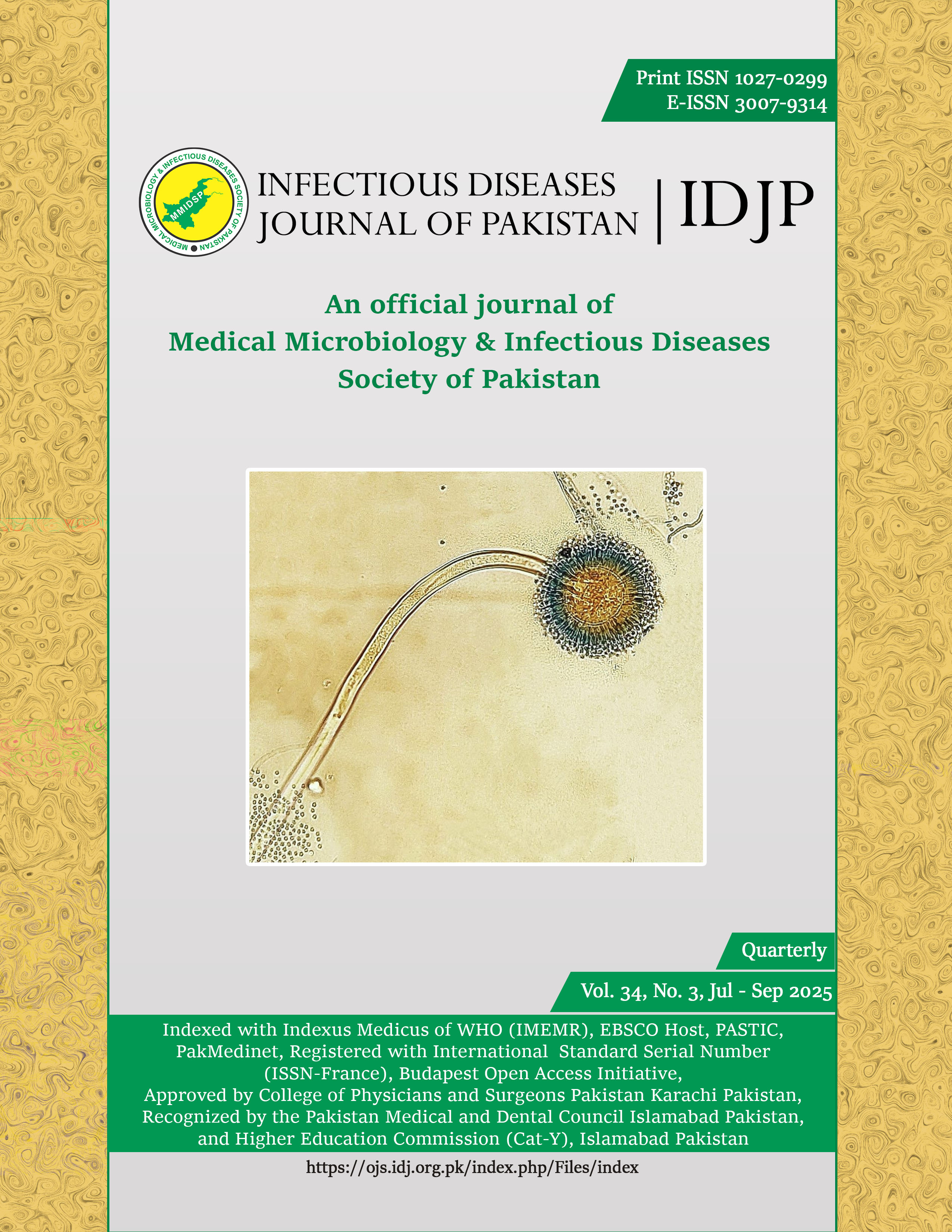Comparison in terms of efficacy between topical clotrimazole and terbinafine for the treatment of fungal otitis externa
DOI:
https://doi.org/10.61529/idjp.v34i3.434Abstract
Background: Fungal otitis externa (FOE), commonly known as otomycosis, is a fungal infection of the external auditory canal that accounts for a significant proportion of ear infections, especially in warm and humid climates. Aspergillus and Candida species are the most common causative agents. This study aimed to compare the efficacy of topical clotrimazole and terbinafine in the treatment of fungal otitis externa in terms of mycological cure and symptom resolution.
Material and Methods: A cross-sectional analytical study was conducted from July 2023 to June 2024 at the ENT Outpatient Department of Bahawal Victoria Hospital, Bahawalpur. A total of 260 patients diagnosed with FOE were randomly assigned to two treatment groups: Group A received clotrimazole 1% solution and Group B received terbinafine 1% cream twice daily for four weeks. Mycological cure and symptom improvement were assessed at week 4.
Results: Mycological cure was achieved in 111 (85.4%) of patients in the terbinafine group compared to 91 (70.0%) in the clotrimazole group (p < 0.001). Terbinafine also showed faster symptom relief and fewer adverse effects (2.3% vs. 7.7%).
Conclusion: Topical terbinafine demonstrated significantly better mycological and clinical outcomes than clotrimazole in treating fungal otitis externa, with an improved safety profile.
Keywords: Aspergillus, Antifungal agents, Clotrimazole, Otitis externa, Terbinafine
References
Chauhan S. Surender. Clinico-mycological profile of otomycosis in chronic suppurative otitis media patients attending a tertiary care teaching hospital. J Pure Appl Microbiol. 2021; 15(2): 813-8. DOI: https://doi.org/10.22207/JPAM.15.2.35
Allaw F, Zahreddine NK, Ibrahim A, Tannous J, Taleb H, Bizri AR, et al. First Candida auris outbreak during a COVID-19 pandemic in a tertiary-care center in Lebanon. Pathogens. 2021; 10(2): 157. DOI: https://doi.org/10.3390/pathogens10020157
Shashikala BS, Deepthi P, Viswanatha B. Fungal flora in chronic suppurative otitis media: A prospective study in a tertiary care hospital. Res Otolaryngol. 2018; 7(1): 5-8. DOI: https://doi.org/10.5923/j.otolaryn.20180701.02
Salah H, Houbraken J, Boekhout T, Almaslamani M, Taj-Aldeen SJ. Molecular epidemiology of clinical filamentous fungi in Qatar beyond Aspergillus and Fusarium with notes on the rare species. Med Mycol. 2023; 61(1): myac098.
DOI: https://doi.org/10.1093/mmy/myac098
Tyler MA, Lam K, Marino MJ, Yao WC, Schmale I, Citardi MJ, Luong AU. Revisiting the controversy: The role of fungi in chronic rhinosinusitis. Int Forum Allergy Rhinol. 2021 Nov;11(11):1577-1587. DOI: https://doi.org/10.1002/alr.22826
Vennewald I, Schonlebe J, Klemm E. Mycological and histological investigations in humans with middle ear infections. Mycoses. 2003 Feb;46(1‐2):12-8. DOI: https://doi.org/10.1046/j.1439-0507.2003.00835.x
Atoui A, Omeirat N, Fakhreddine O, El Alam R, Kanafani Z, Abou Dalle I, et al. The use of voriconazole as primary prophylaxis for invasive fungal infections in patients undergoing allogeneic stem cell transplantation: a single center’s experience. J Fungi. 2021; 7(11): 925. DOI: https://doi.org/10.3390/jof7110925
Ghannoum MA, Rice LB. Antifungal agents: Mode of action, mechanisms of resistance, and correlation of these mechanisms with bacterial hybrid counterparts. Clin Microbiol Rev. 1999; 12(4): 501-17. DOI: https://doi.org/10.1128/cmr.12.4.501
Dixon DM, Walsh TJ. Antifungal Agents. In: Baron S, editor. Medical Microbiology. 4th edition. Galveston (TX): University of Texas Medical Branch at Galveston; 1996. Chapter 76. Available from: https://www.ncbi.nlm.nih.gov/books/NBK8263/
Jimenez-Garcia L, Celis-Aguilar E, Diaz-Pavon G, Munoz Estrada V, Castro-Urquizo A, Hernández-Castillo N, et al. Efficacy of topical clotrimazole vs. topical tolnaftate in the treatment of otomycosis. A randomized controlled clinical trial. Braz J Otorhinolaryngol. 2020; 86(3): 300-7. DOI: https://doi.org/10.1016/j.bjorl.2018.12.007
Mofatteh MR, Yazdi ZN, Yousefi M, Namaei MH. Comparison of the recovery rate of otomycosis using betadine and clotrimazole topical treatment. Braz J Otorhinolaryngol. 2018; 84(4): 404-9. DOI: https://doi.org/10.1016/j.bjorl.2017.04.004
Wu S, Cheng Y, Lin S, Liu H. A comparison of antifungal drugs and traditional antiseptic medication for otomycosis treatment: a systematic review and meta-analysis. Front Surg. 2021; 8: 739360. DOI: https://doi.org/10.3389/fsurg.2021.739360
Anwar K, Gohar MS. Otomycosis; clinical features, predisposing factors and treatment implications. Pak J Med Sci. 2014; 30(3): 564. DOI: https://doi.org/10.12669/pjms.303.4106
Bilal H, Zhang D, Shafiq M, Khan MN, Chen C, Khan S, et al. Epidemiology and antifungal susceptibilities of clinically isolated Aspergillus species in South China. Epidemiol Infect. 2023; 151: 1–11. DOI: https://doi.org/10.1017/S095026882300167X
Mofatteh MR, Fersheh MA, Nikoomanesh F, Namaei MH. Comparing the therapy of otomycosis using clotrimazole with iodine tincture. A clinical trial. Iranian J Otorhinolaryngol. 2021; 33(4): 229-35. DOI:https://doi.org/10.22038/ijorl.2021.51647.2751
Gulustan F, Abakay MA, Demir E. Efficacy of topical isoconazole nitrate in the treatment of otomycosis. Am J Otolaryngol. 2021; 42(4): 102961. DOI: https://doi.org/10.1016/j.amjoto.2021.102961
Sangaré I, Amona FM, Ouedraogo RW, Zida A, Ouedraogo MS. Otomycosis in Africa: Epidemiology, diagnosis and treatment. J Med Mycol. 2021; 31(2): 101115. DOI: https://doi.org/10.1016/j.mycmed.2021.101115
Yang TH, Young YH. Eradicating otomycosis with terbinafine solution: basic and clinical investigation. Audiol Neurootol. 2019; 24(4): 183-90. DOI: https://doi.org/10.1159/000501540
Downloads
Published
How to Cite
Issue
Section
License
Copyright (c) 2025 Editor Office

This work is licensed under a Creative Commons Attribution-NonCommercial 4.0 International License.



